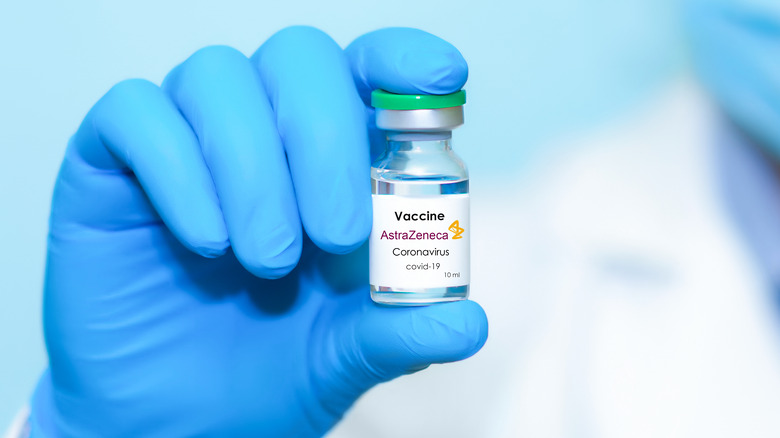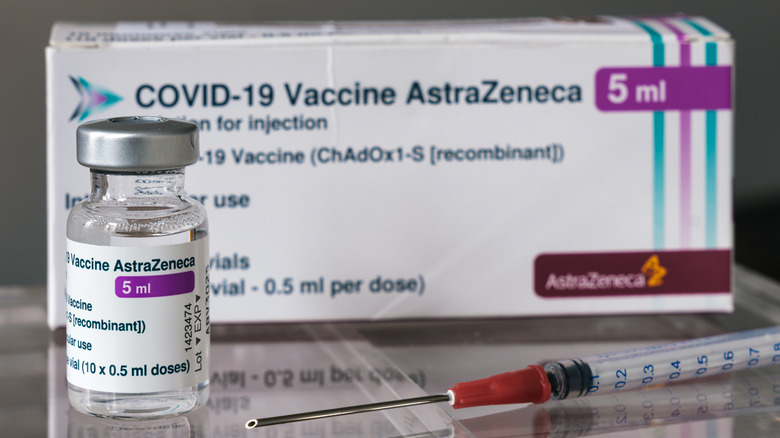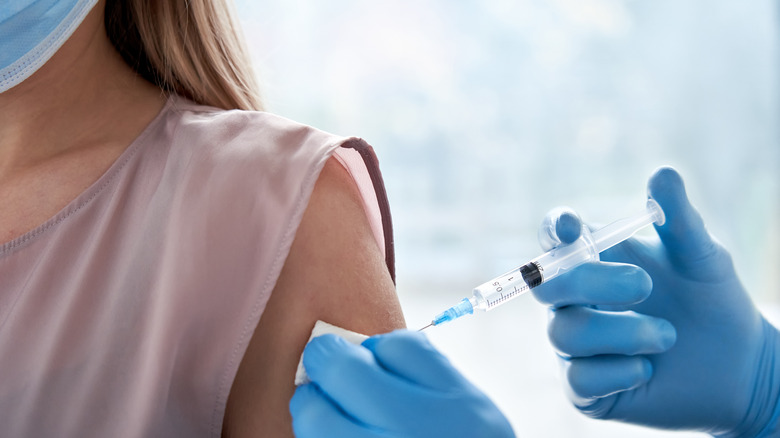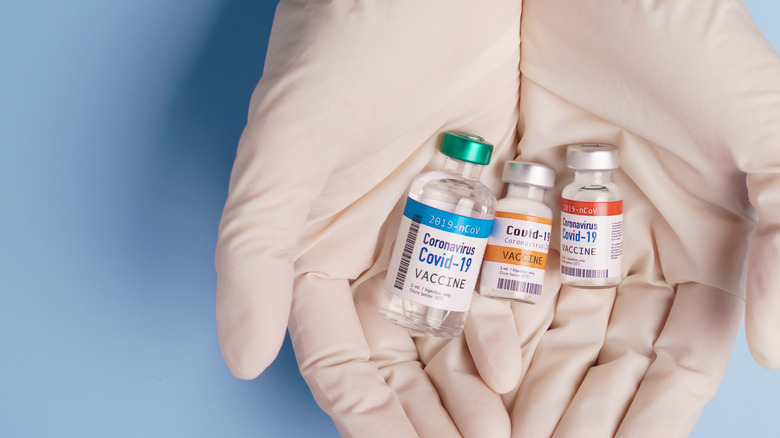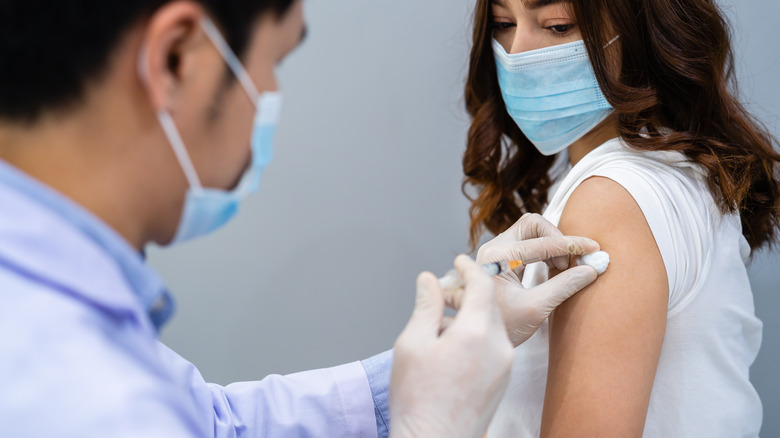Side Effects Of The AstraZeneca Vaccine For COVID-19 Explained
Since the beginning of the COVID-19 pandemic, countries around the world have been working hard to develop vaccines to fight against the disease. There are currently 17 different vaccines being used to fight the coronavirus: Oxford-AstraZeneca, Pfizer-BioNTech, Moderna, GamalGamaleya (Sputnik V), Sinopharm-Beijing, Sinovac, Johnson & Johnson, BBIBP-CorV, Bharat Biotech (Covaxin), CanSino, Sinopharm-Wuhan, Vector Institute (EpiVacCorona), Abdala, Soberana02, QazVac, Sinopharm/HayatVax, and RBD-Dimer (via New York Times).
The Oxford-AstraZeneca vaccine, also referred to as the AstraZeneca vaccine or Vaxzevria, is currently being used in 178 countries including Canada, Australia, and much of Europe and South America. It has not been authorized for use in the United States. The vaccine was approved by the World Health Organization (WHO) for emergency use on February 15, 2021 (via World Health Organization).
According to WHO, the organization "assessed the quality, safety and efficacy data, risk management plans and programmatic suitability, such as cold chain requirements" of the vaccine during a 4-week process. Similar to other COVID-19 vaccines, this process is much faster than normal vaccine studies, but the manufacturers were still required to meet all data requirements set by the World Health Organization.
Most of the AstraZeneca side effects are similar to those of other vaccines
According to Yale Medicine, the most common side effects of the AstraZeneca vaccine include "tenderness, pain, warmth, redness, itching, swelling or bruising at the injection site, all of which generally resolve within a day or two." These are consistent with common side effects experienced by other popular vaccines including Pfizer-BioNTech and Moderna.
The vaccine, according to AstraZeneca, is shown to be 76% effective at "reducing the risk of symptomatic disease 15 days or more after receiving the two doses" and 100% effective against developing a severe case of the disease. However, the National Institute for Allergy and Infectious Diseases (NIAID) has suggested that this data is incomplete and that the actual efficacy may be lower. A January 2021 analysis of four studies regarding the AstraZeneca vaccine concluded that the overall efficacy is 70.4% (via National Institutes of Health). This vaccine requires two doses given four to 12 weeks apart for full efficacy.
The AstraZeneca vaccine has not been authorized for emergency use in the United States because the FDA has not found that AstraZeneca's vaccine trials provided enough accurate information about their safety and efficacy (via Healthline).
The vaccine had a setback in March 2021
By March 19, 2021, at least 18 people who had received the AstraZeneca vaccine had developed rare blood clots in the brain following their shot (via Reuters). About 12 other blood clot cases had been reported by mid-March as well, prompting multiple European countries to suspend the use of the vaccine (via Medical News Today).
At the time, scientists were unsure why the AstraZeneca vaccine would contribute toward such a unique response because its makeup was very similar to several other vaccines that did not report the same potential side effect.
"We'll have to see when [German and Norwegian scientists] submit a peer-reviewed publication and the scientific community can review it," Dr. Peter Hotez, a vaccine researcher at Baylor College of Medicine in Houston, told Reuters. "There's no reason why the AstraZeneca vaccine would do this whereas the others, including the adenovirus-based COVID-19 vaccines, wouldn't."
Some theories about the vaccine's connection to these rare blood clots included that it may trigger an abnormal antibody response or that it was linked to birth control pills.
Blood clots were listed as a potential side effect of the vaccine in April 2021
On April 7, 2021, the European Medicines Agency (EMA) announced that "unusual blood clots with low blood platelets" were added to the list of "very rare" potential side effects of the AstraZeneca vaccine (via European Medicines Agency). The EMA noted that people taking the vaccine should "remain aware of the possibility of very rare cases of blood clots combined with low levels of blood platelets occurring within 2 weeks of vaccination."
Symptoms of this rare side effect include shortness of breath, chest pain, swelling in the leg, persistent stomach pain, severe headaches, blurred vision, and small blood spots under the skin at the injection site.
The EMA noted that while these blood clots can be serious, it is important to remember the seriousness of COVID-19 as well. Due to the severity of the coronavirus, the EMA determined that "the overall benefits of the vaccine in preventing COVID-19 outweigh the risks of side effects" and continue to encourage people to get their vaccines.
There are two types of blood clots listed as potential side effects
Two different types of blood clots are associated with the AstraZeneca vaccine. These include cerebral venous sinus thrombosis and splanchnic vein thrombosis. Cerebral venous sinus thrombosis (CVST) is a rare condition where clots occur in the venous sinuses of the brain (via WebMD). The venous sinuses are veins that sit just underneath the skull. CVST is more common in women than in men.
Risk factors of this condition include pregnancy, high levels of post-pregnancy estrogen, medication with estrogen like birth control, cancer, obesity, collagen vascular diseases like lupus, low blood pressure in the brain, and gut conditions like Crohn's disease. People with previous issues forming blood clots may be more susceptible. COVID-19 can also increase your risk.
Splanchnic vein thrombosis (SVT) refers to blood clots that occur in the abdomen area (via National Institutes of Health). Risk factors of this type of blood clot include cancer, liver cirrhosis, inflammatory bowel disease, autoimmune diseases, pregnancy, infections, abdominal surgery, hormonal therapy, and certain protein deficiencies.
It should be noted once again that these blood clots are extremely rare. The risk of developing one of these clots is about 4 in one million, or 0.000004% (via Healthline). In comparison, 11.2% of people who have had COVID-19 have also developed deep vein thrombosis.
How does the AstraZeneca vaccine for COVID-19 work?
To understand the side effects of the AstraZeneca vaccine, it's important to understand how the vaccine protects you against COVID-19. The AstraZeneca vaccine is a viral vector vaccine. This means it transports DNA from one disease to your cells and allows them to create an immune response from that information (via Medical News Today).
When a bacterial or viral infection is introduced to your body, your immune system fights the molecules from the pathogen and builds up immunity for future battles with that specific infection or disease. While many vaccines send a small infectious pathogen into the body to allow the immune system to fight it directly, viral vector vaccines follow a different method. These vaccines send a piece of genetic code from a pathogen into the body that mimics an infection without introducing the infection itself. However, the body responds to that harmless virus the same way it would respond to a real one and creates an immune system to fight against the infection if the real thing was ever introduced.
According to Medical News Today, the AstraZeneca vaccine "uses a chimpanzee common cold viral vector known as ChAdOx1, which delivers the code that allows our cells to make the SARS-CoV-2 spike protein," which is the spike protein needed to fight against COVID-19.
Viral vector vaccines vs. mRNA vaccines
Two of the most common types of vaccines currently being used are viral vectors and mRNA. The Johnson & Johnson vaccine, currently authorized for emergency use in the United States, is also a viral vector vaccine.
The two other vaccines being used in the United States, Pfizer-BioNTech and Moderna, are mRNA vaccines. These work by using messenger ribonucleic acid (mRNA), which is a molecule that gives cells genetic instructions to make the protein needed to defend against viruses (via Mayo Clinic). Scientists were able to create a synthetic mRNA that could successfully instruct the body to create the SARS-CoV-2 spike protein, and the subsequent antibodies, to fight against COVID-19.
Some people have expressed concerns that an mRNA vaccine can affect your DNA. This is not true. After the protein is made, the body breaks down the genetic instructions from the vaccine and gets rid of them. The mRNA from the vaccine does not affect DNA at all.
While both types of vaccines build spike proteins and antibodies to fight against COVID-19, each goes about the process differently.
Side effects are common in all vaccines
While blood clots are extremely rare, it is normal to experience side effects after getting a vaccine. According to the United Kingdom government, clinical studies of the AstraZeneca vaccine showed that "most side effects were mild to moderate in nature and resolved within a few days" with a few people experiencing symptoms for more than a week (via GOV.UK).
The most common side effects that affect more than 1 in 10 people include tenderness, pain, warmth, itching, or bruising at the injection site, fatigue, chills, headache, nausea, muscle aches, and feeling unwell. Common side effects that can affect up to 1 in 10 people include swelling, redness, or a lump at the injection site, fever, vomiting, diarrhea, high temperature, sore throat, runny nose, cough, and chills. Uncommon side effects that may affect up to 1 in 100 people include feeling dizzy, decreased appetite, abdominal pain, enlarged lymph nodes, excessive sweating, and itchy skin.
Some rare reports of a severe allergic reaction have been reported with the AstraZeneca vaccine, but there is not enough data to confirm that these events happened because of the vaccine.
Who should avoid the AstraZeneca COVID-19 vaccine
The UK government advises that you do not receive the AstraZeneca vaccine if you have ever experienced a severe reaction to any of the ingredients in the vaccine (via GOV.UK). You should also avoid the vaccine if you have ever experienced a blood clot in conjunction with low blood platelets or if you have ever had the condition heparin-induced thrombocytopenia and thrombosis.
If you are unsure about your risk factors, talk to your doctor. You should also speak to a pharmacist, doctor, or nurse before getting the vaccine if you have ever had a negative reaction to a vaccine, have an infection at the time of injection, are taking a blood thinner, have a weakened immune system, or have ever experienced a blood clot in the sinus veins of the brain.
The Australian government recommends the Pfizer-BioNTech vaccine for people with a history of cerebral venous sinus thrombosis or heparin-induced thrombocytopenia (via Australian Government Department of Health). They also advise the Pfizer-BioNTech vaccine for people who are pregnant if possible, but note that the AstraZeneca vaccine may still be worth the risks for some people.
Why vaccines are important
Vaccines have been an important part of public health since the first modern vaccine emerged in the 20th century. Vaccines help prevent the spread of dangerous diseases. Many deadly diseases have been eradicated or are easily prevented thanks to vaccines. These include polio, tetanus, the flu, hepatitis B, hepatitis A, rubella, Hib, measles, whooping cough, pneumococcal disease, rotavirus, mumps, chickenpox, and diphtheria (via Centers for Disease Control and Prevention).
Vaccines can also keep you from getting other health issues caused by the disease a vaccine is created to prevent. For example, skipping your chickenpox vaccine can make you more susceptible to getting shingles later in life (via National Foundation for Infectious Diseases). They can also prevent premature death. About 50,000 adults die every year in the United States from vaccine-preventable diseases, not including COVID-19.
According to Harvard Health Publishing, vaccines can save parents hundreds, if not thousands, of dollars in medical costs. The cost of a preventative vaccine is significantly cheaper than doctor's office or hospital visits due to a vaccine-preventable disease. Vaccines also improve the financial health of a country because they decrease the cost of health care needed to treat those diseases.
Vaccines are often the only way to reach herd immunity
You have probably heard the term "herd immunity" thrown around since the beginning of the COVID-19 pandemic. This refers to the event when a significant portion of a given population is immune to a disease (via WebMD). When most people are immune, the disease has nowhere to go and cannot spread at detrimental levels.
Herd immunity can be reached when resistance is developed naturally or when a majority of the population is vaccinated against the disease in question. It often occurs as a combination of both. According to Johns Hopkins Bloomberg School of Public Health, 50% to 90% of a population needs to be immune to a disease before herd immunity is reached. The ideal number will depend on the severity of the disease and how contagious it is. Regarding especially contagious and deadly diseases like COVID-19, vaccines are often the only way to reach herd immunity without a significant loss of life.
If you have any concerns about receiving the AstraZeneca vaccine (or any COVID-19 vaccine), talk to your doctor. They can help you understand why vaccines are so important to help the world move past this pandemici. They can also help you know when to get the vaccine, what side effects to expect, and whether or not you should wait until another option is available.

